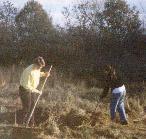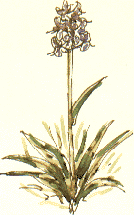 |
To Mow a MeadowMonday 18th September 2000, 2/2, West Yorkshire |
![]()
![]()
![]()
![]()
![]() Nature
Diary Rocks
History
Workshop
Links
Home Page
Nature
Diary Rocks
History
Workshop
Links
Home Page
![]()
 WHEN WE visited the Brickyard Plantation today the results of all that mowing and coppicing were obvious. We noticed dried seedheads of orchids on the open area known as the Plateau.
WHEN WE visited the Brickyard Plantation today the results of all that mowing and coppicing were obvious. We noticed dried seedheads of orchids on the open area known as the Plateau.If the meadow was left unmown it would soon revert to woodland. It's a cliché of conservation that planting trees creates wildlife habitat but here it is different; we need to cut down trees, or rather cut back saplings, to preserve a rare patch of wildflower meadow.
 Whether we can keep the rich mix of wildflowers, which include Orchids, Birdsfoot Trefoil and Yellow Rattle is doubtful. Mowing certainly keeps the clearing open, but to encourage wildflowers we need to keep nutrient levels low. Ideally we should rake off the mown grass; a huge job to tackle without a baling machine. Unpredictable wet weather makes it difficult to plan such tasks, but leaving the grass to lie where it is cut not only builds up nutrients, it also cuts down the light that orchids and other flowers need to germinate.
Whether we can keep the rich mix of wildflowers, which include Orchids, Birdsfoot Trefoil and Yellow Rattle is doubtful. Mowing certainly keeps the clearing open, but to encourage wildflowers we need to keep nutrient levels low. Ideally we should rake off the mown grass; a huge job to tackle without a baling machine. Unpredictable wet weather makes it difficult to plan such tasks, but leaving the grass to lie where it is cut not only builds up nutrients, it also cuts down the light that orchids and other flowers need to germinate. It is likely that coarser grasses will take over the meadow and, in place of the original flora, we'll end up with something that resembles the rough grass that you'd see alongside a motorway. One end of the meadow has been colonised by taller plants such as Knapweed and Rosebay Willowherb. These are not without their wildlife value, but they're not as scarce as the smaller wildflowers.
It is likely that coarser grasses will take over the meadow and, in place of the original flora, we'll end up with something that resembles the rough grass that you'd see alongside a motorway. One end of the meadow has been colonised by taller plants such as Knapweed and Rosebay Willowherb. These are not without their wildlife value, but they're not as scarce as the smaller wildflowers.Grazing sheep on the area might be a solution, but that would bring its own problems of management. Is there anybody out there with Jacob's or Soay Sheep who could help us out please?
![]()
Richard Bell,
wildlife illustrator
E-mail; 'richard@willowisland.co.uk'
![]() Next page
Previous page
Nature Diary
Wild
West Yorkshire home page
Next page
Previous page
Nature Diary
Wild
West Yorkshire home page
![]()